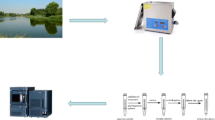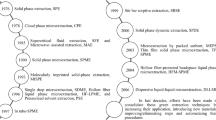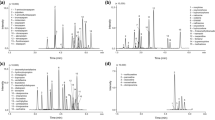Abstract
Drugs of abuse and new psychoactive substances (NPS) for recreational purposes are in constant evolution, and their consumption constitutes a significant risk to public health and road safety. The development of an analytical methodology to confirm the intake of illicit drugs in biological fluids is required for an effective control of these substances. An ultra-performance liquid chromatography–tandem mass spectrometry method (UPLC-MS/MS) was developed for simultaneous determination of 10 synthetic cathinones and 10 illicit drugs in oral fluid easily sampled through non-invasive maneuvers. The UPLC-MS/MS method was coupled to an ultrasound-assisted dispersive liquid–liquid microextraction (US-DLLME), which is a miniaturized and inexpensive technique that uses reduced volumes of solvents and samples. The US-DLLME was optimized by using a 213441//18 asymmetric screening design and a Doehlert design. Sample volume, dispersion and extraction solvent volumes, pH, US time, and amount of sodium chloride were evaluated. The US-DLLME-UPLC-MS/MS method was validated according to international guidelines. Limits of quantitation (LOQs) ranged from 0.25 to 5 ng mL−1, and the linear range spanned from LOQ to 500 ng mL−1 with R2 higher than 0.9907, for most of the target drugs. Precision ranged from 1.7 to 14.8 %RSD. Accuracy, i.e., extraction recovery, ranged from 74 to 129%. The proposed method was successfully applied to the analysis of 15 samples from patients on a drug detoxification program.





Similar content being viewed by others
References
European Monitoring Centre for Drugs and Drug Addiction, European Drug Report 2016: trends and developments, Publications Office of the European Union, Luxembourg, 2016 http://www.emcdda.europa.eu/system/files/publications/2637/TDAT16001ENN.pdf
Miller BL, Stogner JM, Miller JM, Fernandez MI. The arrest and synthetic novel psychoactive drug relationship: observations from a young adult population. J Drug Issues. 2017;47:91–103. https://doi.org/10.1177/0022042616678611.
Rech MA, Donahey E, Cappiello Dziedzic JM, Oh L, Greenhalgh E. New drugs of abuse. Pharmacotherapy. 2015;35:189–97. https://doi.org/10.1002/phar.1522.
Benítez G, March-Salas M, Villa-Kamel A, Cháves-Jiménez U, Hernández J, Montes-Osuna N, et al. The genus Datura L. (Solanaceae) in Mexico and Spain—ethnobotanical perspective at the interface of medical and illicit uses. J Ethnopharmacol. 2018;219:133–51. https://doi.org/10.1016/j.jep.2018.03.007.
Bosker WM, Huestis MA. Oral fluid testing for drugs of abuse. Clinical Chem. 2009;55:1910–31. https://doi.org/10.1373/clinchem.2008.108670.
Aldlgan AA, Torrance HJ. Bioanalytical methods for the determination of synthetic cannabinoids and metabolites in biological specimens. TRAC Trends Anal Chem. 2016;80:444–57. https://doi.org/10.1016/j.trac.2016.03.025.
Mercolini L, Protti M. Biosampling strategies for emerging drugs of abuse: towards the future of toxicological and forensic analysis. J Pharm Biomed Anal. 2016;130:202–19. https://doi.org/10.1016/j.jpba.2016.06.046.
Amaratunga P, Lemberg BL, Lemberg D. Quantitative measurement of synthetic cathinones in oral fluid. J Anal Toxicol. 2013;37:622–8. https://doi.org/10.1093/jat/bkt080.
Di Rago M, Chu M, Rodda LN, Jenkins E, Kotsos A, Gerostamoulos D. Ultra-rapid targeted analysis of 40 drugs of abuse in oral fluid by LC-MS/MS using carbon-13 isotopes of methamphetamine and MDMA to reduce detector saturation. Anal Bioanal Chem. 2016;40:3737–49. https://doi.org/10.1007/s00216-016-9458-3.
Sergi M, Montesano C, Odoardi S, Rocca LM, Fabrizi G, Compagnone D, et al. Microextraction by packed sorbent coupled to liquid chromatography tandem mass spectrometry for the rapid and sensitive determination of cannabinoids in oral fluids. J Chromatogr A. 2013;1301:139–46. https://doi.org/10.1016/j.chroma.2013.05.072.
Newmeyer MN, Concheiro M, Huestis MA. Rapid quantitative chiral amphetamines liquid chromatography-tandem mass spectrometry: method in plasma and oral fluid with a cost-effective chiral derivatizing reagent. J Chromatogr A. 2014;1358:68–74. https://doi.org/10.1016/j.chroma.2014.06.096.
Montesano C, Simeoni MC, Curini R, Sergi M, Lo Sterzo C, Compagnone D. Determination of illicit drugs and metabolites in oral fluid by microextraction on packed sorbent coupled with LC-MS/MS. Anal Bioanal Chem. 2015;407:3647–58. https://doi.org/10.1007/s00216-015-8583-8.
Liu HC, Lee HT, Hsu YC, Huang MH, Liu RH, Chen TJ, et al. Direct injection LC-MS-MS analysis of opiates, methamphetamine, buprenorphine, methadone and their metabolites in oral fluid from substitution therapy patients. J Anal Toxicol. 2015;39:472–80. https://doi.org/10.1093/jat/bkv041.
de Castro A, Lendoiro E, Fernández-Vega H, Steinmeyer S, López-Rivadulla M, Cruz A. Liquid chromatography tandem mass spectrometry determination of selected synthetic cathinones and two piperazines in oral fluid. Cross reactivity study with an on-site immunoassay device. J Chromatogr A. 2014;1374:93–101. https://doi.org/10.1016/j.chroma.2014.11.024.
Mercolini L, Protti M, Catapano MC, Rudge J, Sberna AE. LC-MS/MS and volumetric absorptive microsampling for quantitative bioanalysis of cathinone analogs in dried urine, plasma and oral fluid samples. J Pharm Biomed Anal. 2016;123:186–94. https://doi.org/10.1016/j.jpba.2016.02.015.
Rezaee M, Assadi Y, MilaniHosseini MR, Aghaee E, Ahmadi F, Berijani S. Determination of organic compounds in water using dispersive liquid-liquid microextraction. J Chromatogr A, 2006;1116:1–9. https://doi.org/10.1016/j.chroma.2006.03.007
Jain R, Singh R. Applications of dispersive liquid-liquid micro-extraction in forensic toxicology. TRAC Trends Anal Chem. 2016;75:227–37. https://doi.org/10.1016/j.trac.2015.07.007.
Fisichella M, Odoardi S, Strano-Rossi S. High-throughput dispersive liquid/liquid microextraction (DLLME) method for the rapid determination of drugs of abuse, benzodiazepines and other psychotropic medications in blood samples by liquid chromatography-tandem mass spectrometry (LC-MS/MS) and application to forensic cases. Microchem J. 2015;123:33–41. https://doi.org/10.1016/j.microc.2015.05.009.
World Medical Association Declaration of Helsinki ethical principles for medical research involving human subjects. JAMA J Am Med Assoc. 2013;310:2191–4. https://doi.org/10.1001/jama.2013.281053.
Mathieu D, Nony J, Phan-Tan-Luu R. NemrodW®, Version 2011, LPRAI, Marseille
Lewis GA, Mathieu D, Phan-Tan-Luu R. Pharmaceutical experimental design. New York: Marcel Dekker; 1999. https://doi.org/10.1016/S0378-5173(99)00384-1.
U.S. Department of Health and Human Services Food and Drug Administration, Guidance for industry: bioanalytical method validation, draft guidance, U.S. Department of Health and Human Services Food and Drug Administration, 2013. https://www.fda.gov/downloads/Drugs/%20GuidanceComplianceRegulatoryInformation/Guidances/UCM368107.pdf (Accessed on June 2018).
U.S. Food and Drug Administration Foods and Veterinary Medicine Science and Research Steering Committee, Guidelines for the validation of chemical methods, 2015. https://www.fda.gov/downloads/scienceresearch/fieldscience/ucm273418.pdf (Accessed on June 2018).
ICH harmonized tripartite guideline: validation of analytical procedures: text and methodology Q2(R1), International Conference of Harmonization of Technical Requirements for Registration of Pharmaceuticals for Human Use, 2005. https://www.fda.gov/Drugs/GuidanceComplianceRegulatoryInformation/Guidances/ucm265700.htm (Accessed on June 2018).
Magnusson B, Örnemark U. Eurachem guide: the fitness for purpose of analytical methods—a laboratory guide to method validation and related topics. 2nd ed. Teddington: Eurachem; 2014.
Kruve A, Rebane R, Kipper K, Oldekop M-L, Evard H, Herodes K, et al. Tutorial review on validation of liquid chromatography–mass spectrometry methods: part II. Anal Chim Acta. 2015;870:8–28. https://doi.org/10.1016/j.aca.2015.02.016.
Mansour FR, Khairy MA. Pharmaceutical and biomedical applications of dispersive liquid-liquid microextraction. J Chromatogr B. 2017;1061–1062:382–91. https://doi.org/10.1016/j.jchromb.2017.07.055.
Acknowledgments
The authors are grateful to Professor M.I. Loza (BioFarma Research Group–USC) for assistance with the instrumentation.
Funding
This work was funded by Ministerio del Interior-DGT (Project SPIP2015-01838) of Spain and the European Regional Development Fund (FEDER).
Author information
Authors and Affiliations
Corresponding authors
Ethics declarations
This study has been carried out using oral fluid samples from healthy volunteers and patients participating in substitution therapy programs, authorized by the Comité Autonómico de Ética da Investigación de Galicia Consellería de Sanidade. Xunta de Galicia (SPAIN), with the reference 2015/488, according to Spanish Regulation Law 14/2007, of biomedical investigation and the Real Decreto 1716/2011, of November 18. All the samples have been provided by volunteers and patients who did not oppose to the use of these samples for the development of an analytical method and signed the corresponding informed consent.
Conflict of interest
All authors declare that they have no conflict of interest.
Electronic supplementary material
ESM 1
(PDF 973 kb)
Rights and permissions
About this article
Cite this article
Fernández, P., Regenjo, M., Ares, A. et al. Simultaneous determination of 20 drugs of abuse in oral fluid using ultrasound-assisted dispersive liquid–liquid microextraction. Anal Bioanal Chem 411, 193–203 (2019). https://doi.org/10.1007/s00216-018-1428-5
Received:
Revised:
Accepted:
Published:
Issue Date:
DOI: https://doi.org/10.1007/s00216-018-1428-5




